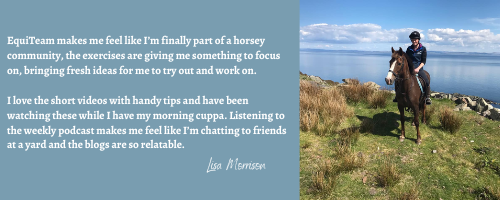EquiTeam member Samantha Bell, shares her journey from pony owning and the challenges of finding the right yard, to the harsh reality of pony owning. Read her next, and final, instalment here.
On the 10th of April 2024 – just ten days before my very first Equiteam camp – Maggie tore a tendon.
The day had started brilliantly. A friend had come to ride her in the school to help me with her tricky left canter lead. She rode beautifully, and before long had Maggie cantering perfect 20m circles – something I’d never managed! Then she suggested I hop on so I could feel the difference, with her guiding us from the ground. Maggie was fabulous. We nailed the left canter without a fuss and had a little celebration.
I decided to trot her round once more before walking off. That’s when it happened. As we set off, she slipped – her back end tucked under her for a second before she recovered. But something felt very wrong. I jumped off, checked her hooves for stones (nothing), I then trotted her up in hand, and even my inexperienced eyes could see she was properly lame.
My partner is a small animal vet physio, so he came to look. Nothing major felt – so we crossed our fingers for a pulled muscle, gave her a borrowed sachet of bute, and hoped she’d be better after a night’s rest.
The next morning, she was still just as lame. Time to call the vet.
Now, Maggie had the most luxurious, snow-white feathers in full bloom, so seeing or feeling anything through them was tricky. The vet couldn’t detect anything obvious at first either as he gave her an examination outside her stable, then he asked to see her move, at which point his face dropped. Out came the clippers. With a little sedation and an ultrasound, things got quiet – never a good sign.
It turned out she’d torn her Manica Flexoria – a band of tissue that forms a sleeve around the deep digital flexor tendon at the fetlock joint, keeping the tendons stable. It’s fairly common in cobs and, in her case, probably the result of small chronic tears before one final “ping” finished the job.
My first thought? Selfishly, was that I wouldn’t be going to camp. But then the bigger fears crept in: no more camps ever… no more riding… maybe even no more Maggie.
The vet was matter-of-fact. Option one: medical management – weeks of box rest, then gradual rehab, with the hope she could return to light hacking. Option two: surgery – a better prognosis, but expensive. There were a few days of weighing everything up and my main concern was, I didn’t think I could afford it without insurance, but thankfully, some family help meant surgery was possible, and she was booked in for the following week.
She stayed in hospital for three days, which turned into seven when the timing clashed with a planned holiday. The hospital were brilliant, sending me daily updates.

Meanwhile, I leaned heavily on my EquiTeam community. Turns out, horses are excellent at finding inventive ways to injure themselves, so I was flooded with advice on box rest, enrichment, and managing my own sanity. Liz even shared her own experience with her daughter’s pony Betsy, who had torn the same thing and was on the road to recovery, which gave me hope.

When Maggie came home, she sported a huge bandage that I had to change myself. “No problem,” I thought – I’m a small animal veterinary nurse. Pahahaha. A horse leg is nothing like a dog leg. You need ten times the padding, ten times the patience, and possibly a degree in structural engineering. Luckily, a yard friend who used to work at the equine hospital rescued me from my lopsided, self-unravelling attempts.
Once the bandage was off, we began rehab. Maggie was a saint on box rest – helped by a steady supply of forage, foraged cow parsley, and stuffed hanging toys. After a few weeks, she graduated to a tiny paddock. Cue me learning to build electric fencing from scratch and move it every couple of days for fresh grass. I was slow at first, but I now consider myself something of a paddock design expert.
We started with in-hand walking. I also bought long-reins, having no idea what I was doing – but Maggie took to it instantly. I suspect she may have had a cart-horse past, as she seemed to steer herself.
Those early weeks were full-on – walking before work, cold hosing, soaking haynets, foraging, and trying to keep her brain busy. After about eight weeks, we were allowed to start ridden walk work.

Sitting behind her ears again felt incredible. In that moment, I thought: If this is all we can ever do again, I can live with that.
We were lucky though. Apart from one small setback – six extra weeks of walk work after a slightly disappointing check-up – Maggie steadily improved. By the 1st of September, we got the go-ahead to start trot. On the 5th of October, we had our first lesson.
Looking at the dates now, I’m so proud of what we’ve achieved. Less than a year later, we’ve been to our first camp (not Equiteam this time, but amazing nonetheless), dipped our toes into dressage, showing, barrel racing, working equitation, horse agility, formation riding, and even cross-country. Our calendar is now full of adventures to come.
This whole journey taught me patience, problem-solving, and to enjoy every moment as you never know what is around the corner.
I’m so glad I took that first step into horse owning, or I’d still be dreaming of what life might be like.
Samantha x
Read the start of Sam and Maggie’s journey – Me? Own a horse? Surely that was for the rich, elite types!
And Part two – Trial and error, learning what really matters.






